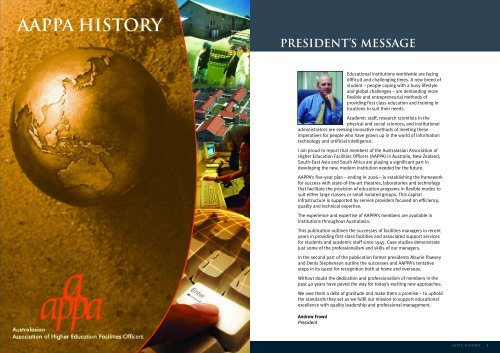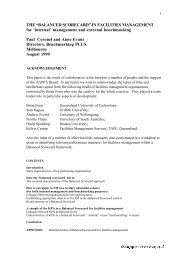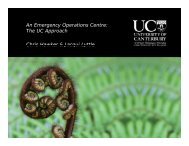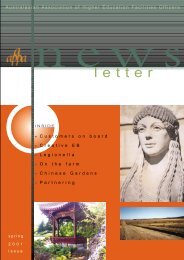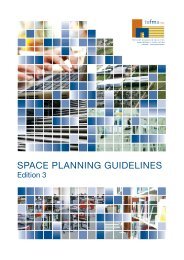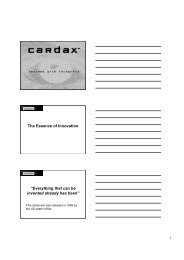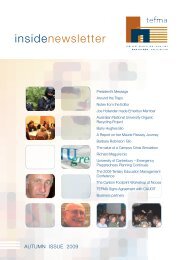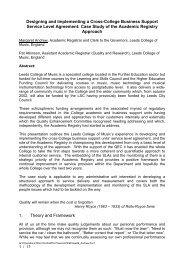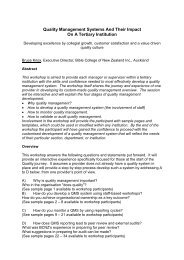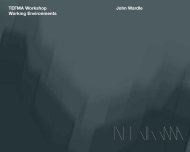aappa history - Tertiary Education Facilities Management Association
aappa history - Tertiary Education Facilities Management Association
aappa history - Tertiary Education Facilities Management Association
You also want an ePaper? Increase the reach of your titles
YUMPU automatically turns print PDFs into web optimized ePapers that Google loves.
AAPPA HISTORY<br />
President’s Message<br />
<strong>Education</strong>al institutions worldwide are facing<br />
difficult and challenging times. A new breed of<br />
student – people coping with a busy lifestyle<br />
and global challenges – are demanding more<br />
flexible and entrepreneurial methods of<br />
providing first class education and training in<br />
locations to suit their needs.<br />
Academic staff, research scientists in the<br />
physical and social sciences, and institutional<br />
administrators are seeking innovative methods of meeting these<br />
imperatives for people who have grown up in the world of information<br />
technology and artificial intelligence.<br />
I am proud to report that members of the Australasian <strong>Association</strong> of<br />
Higher <strong>Education</strong> <strong>Facilities</strong> Officers (AAPPA) in Australia, New Zealand,<br />
South-East Asia and South Africa are playing a significant part in<br />
developing the new, modern institution needed for the future.<br />
AAPPA’s five-year plan – ending in 2006 – is establishing the framework<br />
for success with state-of-the-art theatres, laboratories and technology<br />
that facilitate the provision of education programs in flexible modes to<br />
suit either large classes or small isolated groups. This capital<br />
infrastructure is supported by service providers focused on efficiency,<br />
quality and technical expertise.<br />
The experience and expertise of AAPPA’s members are available in<br />
institutions throughout Australasia.<br />
This publication outlines the successes of facilities managers in recent<br />
years in providing first-class facilities and associated support services<br />
for students and academic staff since 1945. Case studies demonstrate<br />
just some of the professionalism and skills of our managers.<br />
In the second part of the publication former presidents Maurie Pawsey<br />
and Denis Stephenson outline the successes and AAPPA’s tentative<br />
steps in its quest for recognition both at home and overseas.<br />
Without doubt the dedication and professionalism of members in the<br />
past 40 years have paved the way for today’s exciting new approaches.<br />
We owe them a debt of gratitude and make them a promise – to uphold<br />
the standards they set as we fulfil our mission to support educational<br />
excellence with quality leadership and professional management.<br />
Andrew Frowd<br />
President<br />
AAPPA HISTORY 1
2 AAPPA HISTORY<br />
NAVIGATING THE FUTURE<br />
‘Effective and efficient use of space – one of the hottest topics on the<br />
agenda of tertiary institutions…’<br />
‘Building managers are at the coal face of this situation.’<br />
Physical Planning Managers throughout Australia, New Zealand and<br />
South-East Asia are reinventing the wheel…<br />
NAVIGATING THE FUTURE<br />
In Sydney, Australia, a major work of ceremonial architecture, The<br />
Scientia, has transformed the University of New South Wales campus<br />
and given it a poetic and emblematic focus…<br />
At La Trobe University’s major campus in Melbourne, Australia’s first cogeneration<br />
plant at a university is providing substantial power for<br />
student needs and also contributing energy to the national grid…<br />
In Hong Kong, a city notoriously short of land, the Hong Kong University<br />
of Science and Technology’s Estates <strong>Management</strong> Office won the<br />
International <strong>Facilities</strong> <strong>Management</strong> award for facilities excellence – the<br />
first time it has been awarded outside the USA and the first time to a<br />
University…<br />
In New Zealand, Massey University’s Albany campus’ Quadrangle Block,<br />
was awarded the Shieff Angland award for excellence in property<br />
development and investment for special purpose use…<br />
In every higher education institution in Australia, New Zealand and<br />
South-East Asia dedicated engineers, architects, landscape designers –<br />
Members of the Australasian <strong>Association</strong> of Higher <strong>Education</strong> <strong>Facilities</strong><br />
Officers (AAPPA) – are planning and implementing student and staff<br />
facilities for a new age – one ‘unencumbered by the familiar constraints<br />
of time and space’*.<br />
And they are winning awards and commendations from professional and<br />
community organisations for their innovation and problem solving.<br />
In alliances with senior academic administrators, members of AAPPA are<br />
setting benchmarks in building design, energy management,<br />
landscaping, and the provision of laboratory and teaching facilities for a<br />
new education and research age.<br />
Their expertise is helping to transform inner-city campuses and blend<br />
new buildings with old to enhance the teaching environment.<br />
On greenfields sites, the <strong>Association</strong>’s guidelines ensure that teaching<br />
and student facilities are in harmony with the surrounding community.<br />
Above all AAPPA’s professionalism ensures that it is a global partner in<br />
learning – fulfilling its mission to support educational excellence with<br />
quality leadership and professional management through education,<br />
research and recognition.<br />
Through the AAPPA network, members are working together in the<br />
Pacific region, South-East Asia and South Africa. And their interaction is<br />
bringing a fresh perception to the emerging challenges on campuses and<br />
in communities.<br />
The following projects provide a ‘snapshot’ of recent successes of<br />
AAPPA members. They have been selected at random, but reflect the<br />
professional achievements of members on every campus.<br />
* Daig Le, Stephen L., and Cuoco, Patricia M., Grasping the Momentum of the Information Age,<br />
Proceedings of the 1992 CAUSE Annual Conference.<br />
AAPPA HISTORY 3
4 AAPPA HISTORY<br />
CASE STUDY ONE<br />
The La Trobe University co-generation plant – an entrepreneurial exercise<br />
Australia’s first university co-generation plant at La Trobe University’s<br />
Bundoora Campus in Melbourne uses natural gas to drive a gas turbine,<br />
coupled to a generator, to provide the University with electricity. It also<br />
generates high-temperature hot water for heating, domestic applications<br />
and air-conditioning by passing the hot turbine exhaust gas through a<br />
waste heat recovery boiler.<br />
This initiative by La Trobe University has already been justified<br />
economically. It has returned a 97.2 per cent utilisation and shown a<br />
positive profit and loss account indicating it will achieve predicted<br />
savings of up to $1 million a year.<br />
Mr Denis Stephenson, Divisional Manager (Buildings and Grounds) at<br />
the University, said: ‘La Trobe University is proud to have led the way by<br />
installing the first co-generation plant in an Australian university, to have<br />
compiled a complex project brief and specification and to have managed<br />
this $7.6m project to an "on-time" and "on-budget" completion. We<br />
believe it shows that university administrators are fully aware of their<br />
responsibilities in today’s world of rising costs.’<br />
The University was attracted to the co-generation concept because of<br />
the savings that could be achieved by reduced primary fuel costs.<br />
Co-generation has the potential to improve the thermal efficiency of<br />
energy conversion from about 30 per cent for electricity alone, to 75-80<br />
per cent for the combined production of electricity and process heat.<br />
In designing the plant the University was able to satisfy numerous<br />
statutory authorities, including the Victorian State Environment<br />
Protection Authority, on exhaust emissions, liquid discharges, noise<br />
and accidental spillage.<br />
AAPPA HISTORY 5
6 AAPPA HISTORY<br />
CASE STUDY TWO<br />
Massey University’s Albany Campus Quadrangle Building<br />
In New Zealand, the Quadrangle Building at Massey University’s Albany<br />
Campus has won the prestigious Shieff Angland prize in the Property<br />
Council of New Zealand Rider Hunt Building Awards.<br />
The Shieff Angland award is for excellence in property development.<br />
The Quadrangle Building, consisting of four levels and a single<br />
basement, has a floor area of 12,500 square metres. It was built in two<br />
halves and houses elements of the College of Business, the Institute of<br />
Mathematical and Information Sciences, the School of Aviation and<br />
Regional Registry.<br />
Mr Joe Hollander, Massey’s Director of <strong>Facilities</strong> <strong>Management</strong>, who<br />
accepted the award for the University, said he was delighted the new<br />
building had won the award.<br />
He said: ‘It means an innovative design, incorporating special building<br />
intelligence and technology, has been recognised within the building<br />
and property industry. It is also proof of Massey University’s<br />
commitment to excellence in providing an outstanding environment<br />
for tertiary level teaching and research, as well as contributing to an<br />
emerging community in the Albany Basin and supporting the<br />
development of Auckland’s North Shore.’<br />
AAPPA HISTORY 7
8 AAPPA HISTORY<br />
CASE STUDY THREE<br />
University of Newcastle’s Callaghan Campus Nursing Building<br />
In Newcastle, the nursing building at the University of Newcastle’s<br />
Callaghan Campus has been recognised by the New South Wales<br />
Chapter of the Royal Australian Institute of Architects with its inaugural<br />
ESD (Ecologically Sustainable Design) Award.<br />
This benchmark building marries strong design skills and the use of<br />
extensive computer modelling to ensure controllable natural ventilation<br />
in many areas.<br />
A 450-seat theatre is the first application of this scale in Australia to use<br />
a geothermal (ground source heat pump) system in its air conditioning.<br />
This is complemented with a sophisticated mechanical system using a<br />
displacement air distribution system which in turn allows waste heat<br />
recovery, passive humidity control, and fresh air component adjusted by<br />
gas sensor to suit occupancy levels of the theatre.<br />
Occupants of the building acknowledge that in most weather conditions,<br />
the new offices provide a comfortable working environment and, unlike<br />
staff in the fully air-conditioned areas, they appreciate being able to<br />
exert a degree of control over their environment.<br />
AAPPA HISTORY 9
10 AAPPA HISTORY<br />
CASE STUDY FOUR<br />
University of New South Wales, The Scientia<br />
In Sydney, a major work of ceremonial architecture, The Scientia, has<br />
transformed the University of New South Wales Campus.<br />
The Scientia, awarded the Sir Zelman Cowen Award for Public Buildings<br />
by the Royal Australian Institute of Architects, was designed to embody<br />
the progressive spirit of the University.<br />
It creates a place of spontaneous gathering of ceremonial focus for the<br />
University and the wider community.<br />
Making the award, the Jury commented that The Scientia had given the<br />
campus a ‘remarkably poetic and emblematic focus’.<br />
‘The Scientia is a rare highly refined work whose language is<br />
international yet whose varying and changeable transparencies are both<br />
elegantly rational and pragmatically Australian.<br />
The University of New South Wales and the Sydney metropolis are<br />
privileged by this consummate work of public architecture.’<br />
Photographs: John Grollings<br />
AAPPA HISTORY 11
12 AAPPA HISTORY<br />
CASE STUDY FIVE<br />
Griffith University, Logan Campus<br />
In Queensland, Griffith University has developed a new paradigm for its<br />
Logan Campus – moving away from the context of comfortable<br />
convention at its other campuses.<br />
To meet the new age of information technology and its impact on the<br />
way students learn, Griffith’s experts stopped thinking about higher<br />
education as a ‘place’.<br />
Mr Sam Ragusa, the University’s Director of the Office of <strong>Facilities</strong><br />
<strong>Management</strong>, said in developing the Logan Campus their goal was to<br />
create facilities capable of serving as teaching instruments accessible to<br />
students both on and off campus.<br />
He said: ‘The new learners want to be able to start a course at any time of<br />
the year, progress at their own rate, access material from home or office,<br />
or even on the campus at any time of day or night, and complete<br />
assessments when they believe they are competent in the subject matter.’<br />
On the Logan Campus lecture theatres are rarely used for undergraduate<br />
classes. Web-based learning enables the delivery of learning resources<br />
to many locations where students can learn at their own pace or gather<br />
in small groups to discuss the topic and talk with the lecturer and other<br />
students either locally or across cyberspace.<br />
Digitised documents, data and other resources are transmitted<br />
simultaneously.<br />
The remote locations can be other rooms on campus, in schools or<br />
community libraries, training rooms in corporations or factories or<br />
individual internet-linked workstations at home or in the office.<br />
AAPPA HISTORY 13
14 AAPPA HISTORY<br />
CASE STUDY SIX<br />
University of Science and Technology, Hong Kong<br />
In Hong Kong, the Estate <strong>Management</strong> Office (EMO) of the University of<br />
Science and Technology, built to boost student numbers in the Territory,<br />
has won the International <strong>Facilities</strong> <strong>Management</strong> Award for facilities<br />
excellence – the first time it has been awarded outside the USA. It is also<br />
the first time it has gone to a university.<br />
The University’s main academic building of more than 200,000 square<br />
metres, was completed in two phases from 1989 to 1992. In addition<br />
student residences for 2,500 undergraduates and 1,000 postgraduates<br />
have been built along with 500 apartments for faculty and staff families.<br />
Mike Hudson, Director of EMO says: ‘It has been an exciting 13 years,<br />
participating in the growth of a new institution. We have gone through<br />
our formative years and are now maturing into a world class research<br />
institution, with world class facilities.’<br />
HKUST joined APPA and the EMO benefited from an APPA facilities<br />
management review program in 1995. The University is a regular<br />
participant in the <strong>Association</strong>’s benchmarking exercises.<br />
AAPPA HISTORY 15
16 AAPPA HISTORY<br />
CASE STUDY SEVEN<br />
RMIT University, Urban Spaces Project<br />
RMIT University’s main campus in Victoria is undergoing a metamorphosis<br />
– an urban transformation which sheds the University’s fortress-like<br />
image and opens it up to Melbourne’s central business district.<br />
The University’s Urban Spaces Project is so successful it has won the<br />
Walter Burley Griffin Award for Urban Design.<br />
The project, started in 1996, began with the formulation of a strategic<br />
framework to rebuild all of the open space on the campus. This included<br />
paving, planting and street furniture.<br />
Now cluttered streets, lanes, dead-ends and hidden courts have been<br />
transformed into a pedestrian-friendly network of continuous open space.<br />
The most dramatic change is to the University’s main pedestrian spine.<br />
Once a service road full of parked vehicles, it is now an airy, sun-filled<br />
series of plazas.<br />
Presenting the Walter Burley Griffin Award, the jury said: ‘The RMIT<br />
Urban Spaces Project is an on-going award of distinguished urbanity and<br />
value to both the University and inner Melbourne. In reworking the City<br />
Campus and discovering its intricacy and delights, the University has<br />
given a singularly valuable gift to both its own community and<br />
Melbourne at large.’<br />
Peter Elliott Pty Ltd, Architecture and Urban Design. Photographs: John Gollings<br />
AAPPA HISTORY 17
18 AAPPA HISTORY<br />
AAPPA – THE GENESIS<br />
This short <strong>history</strong> by MAURIE PAWSEY, of The University of Melbourne,<br />
and edited by DENIS STEPHENSON, of La Trobe University, traces the<br />
initial struggle for recognition of AAPPA pioneers, not only in their home<br />
institutions but overseas. It also incorporates contributions from Bill<br />
Humble, Ted Dews, Sam Ragusa and Russell Candy.<br />
Maurie Pawsey, inaugural president of AAPPA (1989-1991) and Denis Stephenson, president of AAPPA (1997)<br />
In the beginning…<br />
Facility management in Australia grew from a modest beginning. In<br />
1945, at the end of the Second World War, Australia had only seven<br />
universities, two in New South Wales and one in each of the other<br />
States. It is doubtful whether any had a particular person with sole<br />
responsibilities and duties of a <strong>Facilities</strong> Manager.<br />
After the war returned servicemen and women flocked into university<br />
training schemes dramatically changing somnolent universities – many<br />
still in a nineteenth century mode. The University of Melbourne, for<br />
example, had 4,500 EFT enrolments in 1945. By 1950, this had grown to<br />
9,000, declining in 1955 to 7,000, and then after the Murray Commission<br />
Report (Sir Keith Murray, 1958) growing to more than 11,000 by 1980.<br />
A new approach was needed but university administrations were slow to<br />
react. The University of Melbourne did not appoint a Buildings Officer<br />
with specific facility management tasks until 1958.<br />
An emergency building program across the established universities<br />
began in the late 1940s continued through the 1950s. It was formalised<br />
by the Murray Commission Report and the establishment of the<br />
Australian Universities Commission, and the first capital funding<br />
Triennium of 1958 – 60.<br />
New universities on greenfield sites were also established at this time<br />
including the Australian National University, Monash, Macquarie,<br />
La Trobe, Flinders, Murdoch, and Griffith. All appointed professionals<br />
as facilities managers from the start, although titles such as Buildings<br />
Officer or Director (Buildings and Grounds) were the more common<br />
usage at that time.<br />
By the time a slow down in building activity came about in the 1976 – 78<br />
Triennium, the original seven universities had become nineteen, all with<br />
significant facilities management organisations, largely based on the<br />
British estates management model.<br />
The tertiary level of education was also being served by a system of<br />
Colleges of Advanced <strong>Education</strong> (CAE) and Institutes of Training and<br />
Further <strong>Education</strong> (TAFE).<br />
AAPPA HISTORY 19
20 AAPPA HISTORY<br />
Need for a professional association…<br />
It was obvious that a professional approach was needed. The genesis of<br />
AAPPA occurred in the early 1970s, when a number of Buildings Officers<br />
in Australia became interested in exchanging information and<br />
experience. They realised that they had much to learn from each other.<br />
Initially this exchange began by visiting other campuses for discussions,<br />
followed by the establishment of small informal groups and then larger<br />
gatherings (for example, the NSW Buildings Group.) Contact was being<br />
made at this time with colleagues in New Zealand.<br />
It was soon realised that the breadth of experience and information<br />
needed was unavailable in Australia but there were opportunities in the<br />
much larger North American systems. People such as Bill Humble<br />
(University of Queensland), Alan Cole (Griffith University), Ted Dews<br />
(James Cook University), Geoff Harrison (Flinders University), Maurie<br />
Pawsey (University of Melbourne), and Denis Stephenson (La Trobe<br />
University), became members of APPA (<strong>Association</strong> of Physical Plant<br />
Administrators), and/or SCUP (Society for College and University<br />
Planning) and began to attend their annual meetings.<br />
There were serious challenges at this time for Australia’s Buildings<br />
Officers, whose responsibilities covered all aspects of physical planning,<br />
capital development and facilities management. The question to be<br />
addressed was whether APPA, SCUP, or perhaps NACUBO (Business<br />
Officers’ <strong>Association</strong>) would be the most appropriate contact or focus<br />
for Australian practitioners. The then (and in some cases current) North<br />
American practice of separating Planning/Space <strong>Management</strong>/<br />
Construction into a Planning and Construction Office, away from the<br />
operational arm of Maintenance/Custodial/Grounds/Security/Traffic<br />
Office based on their State/Institutional funding sources was strange to<br />
Australians and New Zealanders. In many cases it still is.<br />
APPA or SCUP?…<br />
Australian visitors began to achieve recognition among their American<br />
peers by presenting technical papers at the US annual meetings.<br />
Correspondence also began to flow between our contacts in North<br />
America, and some Australians had articles published in US professional<br />
journals. By the late 1970s/early 1980s, Australians, represented by Bill<br />
Humble, Maurie Pawsey and Geoff Harrison, began to receive invitations<br />
to be members of APPA and SCUP Committees – usually the International<br />
Committee. On these they continued to lobby for both organisations to<br />
recognise their international opportunities and obligations.<br />
Around the end of the 1970s and into the 1980s, SCUP suffered a decline<br />
in membership, its influence and then a financial decline. APPA, however,<br />
continued to grow and widen its influence. To Australians, it appeared to<br />
be the organisation to support. In more recent years, SCUP has made a<br />
‘comeback’, and Australians have again been involved in both organisations.<br />
Throughout the 1980s, we in Australia made a strong effort to ensure<br />
that Australian universities were represented at every annual APPA<br />
conference, and at SCUP conferences whenever possible. It also became<br />
essential to remind APPA regularly of our presence by contributing<br />
papers. Strategies to bring our existence to the attention of members<br />
were many and varied. A slide showing Australia superimposed on<br />
mainland USA was a telling graphic of Australia’s existence and size.<br />
In the late 1980s Bill Humble and Maurie Pawsey became members of<br />
the APPA International Committee. However, before recording the next<br />
stages of the move into the North American scene, we need to look at<br />
developments in Australasia at this time.<br />
AAPPA HISTORY 21
22 AAPPA HISTORY<br />
Developments in Australasia…<br />
While we were pursuing our goals in the USA, it also became obvious<br />
that we needed to share our experience and ideas at home. Visits to<br />
other universities were becoming common as we recognised the value of<br />
such exchanges. In the early 1970s, a New South Wales Buildings<br />
Officers Group was formed. It met several times a year and also<br />
attracted Buildings Officers from Queensland and Victoria.<br />
More informal groups started in other States and some Buildings<br />
Officers took part in the fledgling Australian Institute of <strong>Tertiary</strong><br />
<strong>Education</strong>al Administrators (AITEA). As groups similar to the Buildings<br />
Officers discipline-based group emerged, such as Staff Officers, the<br />
Australian Vice-Chancellors’ Committee (AVCC) became concerned at the<br />
growing number of conferences. All specific interest groups were<br />
directed to work through AITEA, which later changed its name to the<br />
Australasian <strong>Association</strong> for <strong>Tertiary</strong> <strong>Education</strong> <strong>Management</strong> (ATEM).<br />
Energy <strong>Management</strong> Conference 1979…<br />
After several visits to the USA, some Australian Buildings Officers realised<br />
the potential savings in managing power – both electricity and gas.<br />
This was a new field in Australia. Programs such as the inappropriately<br />
named ‘Killerwatt’ program at the University of Melbourne started in<br />
1977, producing savings of more than $100, 000 in 1978, and millions of<br />
dollars in subsequent years. Similar programs became common across<br />
the university sector.<br />
The AVCC appreciated this work, and agreed to sponsor a Conference on<br />
Energy <strong>Management</strong> in Australian Universities at the University of<br />
Melbourne in August 1979. Forty-four representatives of the then<br />
nineteen universities attended, with speakers including Professor Noel<br />
Dunbar, Chairman of the Australian Universities Commission, and Dr<br />
Howard Worner, Chairman of the National Energy Advisory Committee.<br />
The Organising Committee for this landmark conference was Bill Humble<br />
(University of Queensland), Professor Luxton (University of Adelaide), Ian<br />
Way (University of NSW), and Maurie Pawsey (University of Melbourne).<br />
As an outcome of this conference, the AVCC agreed to a review<br />
conference by August 1981, and the establishment of a Secretariat (at<br />
the cost of the sponsoring university), which was initially the University<br />
of Melbourne, and later the University of New South Wales. The<br />
Secretariat was to obtain energy management statistics and ideas, and<br />
circulate a newsletter and bibliography twice a year.<br />
From left rear row:<br />
AVCC energy and maintenance conferences…<br />
The 1981 conference was duly held at the University of New South Wales,<br />
and by the time of the 1983 Conference at the University of Sydney,<br />
convened by Phil Westwood, the AVCC had agreed to include Maintenance<br />
in an ‘Energy and Maintenance Conference’. It had also accepted the role<br />
of facilities management as an essential element in university operations.<br />
An ongoing pattern emerged of supported conferences, with the next<br />
Energy and Maintenance Conference being held in September 1985 in<br />
Canberra, where Maintenance became the emerging theme, with a whole<br />
morning being devoted to the subject, presented by Phil Westwood<br />
(University of Sydney), Don Long (Macquarie University), Bill Humble<br />
(University of Queensland), and Maurie Pawsey (University of Melbourne).<br />
A Maintenance and Energy Conference was held at Newcastle University<br />
in August 1987, with Maurie Edmunds as convener.<br />
During planning for the 1989 conference, with the approval of the AVCC<br />
for our activities, the title of the conference was changed to the <strong>Facilities</strong><br />
<strong>Management</strong> Conference, and moved to an annual cycle. Convened by<br />
Sam Ragusa, it was held in July 1989 at Griffith University.<br />
5. Ron Moore, David Low, Stephen Harrison, Paul Bowler, Phil Hebblethwaite, Don Long, Adrian Mengede, Arthur Bradley, Russell Englefield, Richard McWhinney, Nigel Postill, Ray Morley.<br />
4. Ron Hicks, Neil Derrington, Ed Naretto, Neil Shannon, Maurice Matthewson, Dennis Morgan, Graeme Dennehy, Bruce Hogan, Peter Renton, Neil Thyer, Norm Cornwell, Gary Popplewell, Denis Stephenson, Geoff Harrison.<br />
3. Jim Burrough, Roger Dodd, Kevin Turnbull, John Trembath, Trevor Mowbray, Riduan Osman, Jim Stone, John Simmons, Heith Sutherland, Bob Grant, Lloyd Cushway, Bob Brownlie.<br />
2. Max Wedde, Maurie Edmonds, Maurie Pawsey, Andrew Drever, Geoff Webber, Alan Yagenegi, Ian Brown, John Harrington, Greg Gow, John McDonagh, Brian Goodhind.<br />
1. Frank Bromilow, Laurie Lardner, Sam Ragusa, Dorsey Jacobs, Ed Bulley, Russell Candy, MS Wong, Heather Greaves, Gordon Dixon.<br />
AAPPA HISTORY 23
24 AAPPA HISTORY<br />
The 1990 <strong>Facilities</strong> <strong>Management</strong> Conference, convened by Ken Harrison,<br />
was held in September at the Australian National University in Canberra.<br />
The last AVCC <strong>Facilities</strong> <strong>Management</strong> Conference was held in October<br />
1991 in Adelaide with Lloyd Cushway as convener. These last three<br />
conferences were linked to our connections and advancement with APPA.<br />
Since 1992, the AAPPA annual meeting and conference has been held in<br />
conjunction with the AITEA (now ATEM) annual meeting and conference.<br />
This was held in Ballarat.<br />
Meanwhile other facilities management initiatives were pursued including<br />
a National Committee on Rationalised Building, and its Asset <strong>Management</strong><br />
Committee. This Committee included university representatives and it<br />
participated in the forthcoming Ritchie Committee (chaired by Jim Ritchie,<br />
University of Queensland). Other activities included AITEA Special Interest<br />
Groups, the New Zealand Works Registrar’s Course and the AVCC Working<br />
Group on Buildings which produced the Ritchie Report setting standards for<br />
Terminology, Charts of Accounts, minimum levels for the funding of<br />
maintenance and space planning guidelines as a prelude for SPAM.<br />
The Ritchie Committee and the later AVCC Working Group (chaired by<br />
Steven Harrison, University of Sydney), involved meetings in Brisbane<br />
and Sydney for the group of Westwood, Humble, Ragusa, Dews, Harrison<br />
(Geoff), and Pawsey, paving the way for the establishment of AAPPA.<br />
This work was important because it substantially raised the status of<br />
Facility Managers with the AVCC and in Australia generally.<br />
Involvement with APPA…<br />
Australia’s involvement with APPA in the USA was initially limited to<br />
attendance at APPA Annual Conferences and Regional APPA Conferences,<br />
visits to North American campuses and occasional articles in APPA and<br />
Regional APPA newsletters. Attendees in the early to mid 1980s included<br />
Geoff Harrison (Flinders University), Trevor Russell and Denis Stephenson<br />
(La Trobe University), Ted Dews (James Cook University), Bill Humble<br />
(University of Queensland), Sam Ragusa (Griffith University), Maurie<br />
Pawsey (University of Melbourne), and Phil Westwood (Sydney University).<br />
It became crucial to submit papers to the conferences to ensure Australia’s<br />
presence was kept before the American power brokers. An example of this<br />
was the San Diego 72nd annual meeting in July 1985, where a joint paper<br />
entitled <strong>Facilities</strong> <strong>Management</strong> Down Under was presented by Bill Humble,<br />
Maurie Pawsey and Sam Ragusa. At this meeting, Australian representatives<br />
continued to lobby vigorously for formal recognition, particularly at the<br />
meeting of the International Committee when all three were present.<br />
They were reminded of the minimum institutional numbers required to form<br />
a Chapter or Region. It was suggested that Australia consider joining the<br />
Pacific Coast Region as an initial step. This was agreed and all Australian<br />
universities were encouraged to take out PCAPPA membership as well as<br />
APPA membership and many did so. Humble, Pawsey, Ragusa and<br />
Westwood also visited several strategically important individuals in their<br />
universities in 1985, continuing to lobby for membership.<br />
Humble and Pawsey also visited the United States of America and<br />
visited eight universities (and their APPA representatives) in California<br />
over a five-day trip.<br />
Negotiations continued with individuals and at conferences in 1986. An<br />
important development was the appointment of former APPA President,<br />
Rex Dillow as an interim Executive Director of APPA, following the<br />
departure of Paul Knapp. Rex Dillow came to Australia as an official<br />
APPA representative to the Newcastle AVCC Maintenance and Energy<br />
Conference in 1987 and became our mentor.<br />
Attendees at APPA Conferences in 1986 and 1987 included Denis<br />
Stephenson (Eastern Region Annual Conference, 1986). In 1988, Humble<br />
and Pawsey again featured as a ‘double bill’ at the Washington APPA<br />
annual meeting, with a paper on Life Cycle Costing. Further<br />
representations were made to meetings of the International Committee<br />
and the APPA Board, facilitated by Rex Dillow and other supporters of<br />
Australasia, notably Jack Hug, Dorsey Jacobs, Ed Naretto, Doug<br />
Christenson and Bill Middleton.<br />
AVCC Maintenance <strong>Management</strong> & Energy Conference. Newcastle – 31 August and 1 September, 1987<br />
From left rear row:<br />
4. Gordon Dixon, Ian Brown, Neil Demeral, Reg Service, Keith Sutherland, John Hoar, Ridnan Osman, Ken Fisher, Lloyd Cushway, Ron Kinnell, Brian Kilfoyle, Andrew Dreaver, Ron Moore, Stephen Harrison, Kevin Turnball.<br />
3. Ivan Hipworth, Geoff Harrison, Phil Hebblethwaite, Max Wedde, Rob Nicol, Peter Renton, Ron Moore, Nick Clark, Paul Bowler.<br />
2. Jim Stone, Roy Burton, John Trembath, Denis Stephenson, Peter Byers, Vern King, Roy Radley, Ken Harrison, John Harrington, John McDonagh, David McGrath, David Henzell.<br />
1. Denis Robinson, Ted Dews, Bill Humble, Maurie Edmonds, Rex Dillow, Don Morris, Maurie Pawsey, Phil Westwood, Don Long, Brian Fenn, Sam Ragusa.<br />
AAPPA HISTORY 25
26 AAPPA HISTORY<br />
New Zealand…<br />
The involvement with New Zealand was fostered through contacts Rob<br />
Nicol and Maurice Matthewson (University of Auckland), Bob Grant<br />
(University of Waikato), Roger Dodd (University of Otago), David Tai<br />
(Victoria University of Wellington), Russell Englefield (Lincoln University),<br />
and Joe Hollander (Massey University). Joint activities were held which<br />
included the 1987 Works Registrars’ Course and a series of seminars in<br />
following years that had Australian representation. Many New Zealand<br />
members are regular attendees at Australian conferences.<br />
Australasian APPA…<br />
The result of these many years of lobbying and presentations was a decision<br />
of the APPA Board to establish an International Section, with the<br />
Australasian Section of PCAPPA the first – the forerunner to AAPPA. This<br />
decision gave Australasia formal status and recognition. It also gave it some<br />
practical advantages. While we had more than twenty-five APPA members<br />
we were entitled to have a formal exchange of representatives every two<br />
years at APPA expense. Once we achieved forty members, we were entitled<br />
to an annual exchange of representatives. PCAPPA also offered a place on its<br />
Board, with funding assistance to attend its mid-winter meeting.<br />
Australasian APPA was formed in February 1989, with an Interim Board,<br />
comprising Maurie Pawsey, President; Bill Humble and Ted Dews, Vice-<br />
Presidents; and the Secretary/Treasurer, Phil Westwood. Committee<br />
members were Val Rosalion (Victorian College of the Arts), Norm Hughes<br />
(Darling Downs) and Denis Stephenson (La Trobe University).<br />
The goodwill shown by APPA and PCAPPA was immediately reflected in action<br />
as arrangements proceeded for the inaugural annual meeting at Griffith<br />
University in July 1989. Dorsey Jacobs, President of APPA, Ed Naretto, President<br />
of PCAPPA, Ron Hicks, President-Elect of PCAPPA, and twenty-five PCAPPA<br />
members and their wives agreed to come to Griffith. An excellent meeting and<br />
conference was held, crowned by some Sam Ragusa magic – a Fourth of July<br />
fireworks display on the Griffith oval after the conference dinner.<br />
AAPPA became a reality with the Charter presentation by Dorsey Jacobs and<br />
the establishment of a Board, initially appointed for a two-year term. This<br />
Board was made up of Maurie Pawsey, President; Bill Humble and Ted Dews<br />
as Vice-Presidents; Phil Westwood, Secretary/Treasurer, and the Board<br />
members Bob Brownlie, Lloyd Cushway, Don Long, Maurice Matthewson,<br />
Sam Ragusa, and Denis Stephenson. The first Board meeting was held on<br />
5 July 1989 with Dorsey Jacobs, Ed Naretto and Ron Hicks in attendance.<br />
The years as International Section of PCAPPA…<br />
The 76th APPA annual general meeting was held in Reno, Nevada, in 1989.<br />
President Maurie Pawsey attended representing AAPPA (also attending the<br />
PCAPPA Board)as a guest of the APPA Board. By this time we had achieved<br />
the initial target of forty members of APPA. There was some chiding of<br />
AAPPA by APPA that its financial support was limited by APPA’s budget<br />
difficulties. This was met by a reminder that these were our formative<br />
years and that we had over forty members paying full APPA fees.<br />
The 1990 PCAPPA annual meeting was held in September at Turtle Cove<br />
Resort, Hawaii. Six Australians attended, including President Maurie<br />
Pawsey and Vice-President Bill Humble. The second annual meeting of<br />
AAPPA was held in September 1990. It was attended by the President-<br />
Elect for APPA, Jack Hug, the President of PCAPPA, Ron Hicks, five other<br />
PCAPPA members and their wives.<br />
The third annual meeting of AAPPA was held in Adelaide in 1991,<br />
convened by Lloyd Cushway. It was attended by the President-Elect of<br />
APPA, Bill Middleton and his wife, and it was at this meeting that Bill<br />
Humble became President, with Ted Dews as Senior Vice-President and<br />
Sam Ragusa as Secretary/Treasurer.<br />
The 1991 APPA annual meeting was held in Ottawa, Canada, with a<br />
formidable delegation from Australasia attending, including President<br />
Bill Humble, Vice-President Ted Dews, and Sam Ragusa as Secretary/<br />
Treasurer. Joint papers were submitted by Bill Humble (with Maurie<br />
Pawsey), and papers by Ted Dews and Sam Ragusa. This delegation<br />
came home with initial proposals for an Australasian Region of APPA.<br />
In 1992, there was a joint conference with the AITEA annual meeting and<br />
the AAPPA annual meeting in Ballarat. Joe Estill, the APPA President –<br />
Elect attended and Ted Dews became President of AAPPA. It was at this<br />
meeting that more formal and stronger links were formed between AITEA<br />
and AAPPA, with Ted Dews making a formal agreement with the<br />
President of AITEA, Avril McClelland.<br />
AAPPA HISTORY 27
Ted Dews<br />
Don Long<br />
28 AAPPA HISTORY<br />
Australasian APPA: regional status…<br />
AAPPA President Ted Dews attended the 1993 APPA annual meeting in<br />
July, held in St. Louis, USA. It was at this meeting that the APPA Board<br />
conferred full regional status on Australasian APPA. He attended the<br />
meeting of the new APPA Board as the first Australasian Regional<br />
President, and was accorded ‘Top table’ treatment at the conference<br />
dinner including an opportunity to address the assemby.<br />
Sam Ragusa followed as President of AAPPA in 1994. It could be said<br />
that following his term of office, the ‘old Guard’ had done its duty and<br />
took a step back while another generation took the helm. This is not to<br />
say that there were not equally difficult times ahead, not the least being<br />
the resignation of two Presidents-Elect at the last moments before their<br />
annual meetings, and Denis Stephenson having served more terms as<br />
Immediate Past President than there are sunny days in Melbourne!<br />
To complete the list of Presidents of the first decade of AAPPA to the<br />
present, Don Long (Macquarie University) was President in 1995; Lloyd<br />
Cushway (Adelaide University) became President in 1996. Denis<br />
Stephenson (La Trobe University) took the Presidency at the Perth<br />
Conference for 1997, and was followed by Brian Fenn (Queensland<br />
University of Technology) in 1998. The 1999 President was Russell Candy<br />
(University of Western Australia), Maurice Matthewson (University of<br />
Auckland) was President in 2000 when the tenth anniversary Annual<br />
Meeting was held in celebratory fashion in Wellington, New Zealand, and<br />
Robert Kelly was President in 2001. The current President is Andrew Frowd.<br />
<strong>aappa</strong>/ATEM Conference 2000 – "Past Presidents"<br />
Back Row: Bill Humble, Denis Stephenson, Russell Candy, Sam Ragusa, Lloyd Cushway<br />
Front Row: Maurice Pawsey, Robert Kelly (President-2000), Gary Reynolds (Pres. Elect, APPA), Maurie Matthewson, Brian Fenn<br />
This period from 1995 has been one of growth in membership and<br />
increased workload for Board members as they followed the lead of the<br />
parent body APPA in developing strategic plans and delivering better<br />
services. During this period members demanded a return from<br />
investment in membership. It was no longer good enough to deliver a<br />
quarterly newsletter and run an annual conference.<br />
The AAPPA Board gave specific attention to:<br />
• providing services for membership,<br />
• increasing and enriching membership,<br />
• developing a strategic plan for AAPPA,<br />
• increasing professionalism of the Board and its committees,<br />
• integrating the New Zealand chapter into full AAPPA partnership, and<br />
• improving the quality of services, eg newsletter, conferences,<br />
web page, communication.<br />
The first AAPPA Board meeting outside of Australia was held in Nelson to<br />
coincide with a New Zealand chapter conference. This proved to be an<br />
important step in the development of AAPPA. It demonstrated to the<br />
New Zealand membership that they were truly part of AAPPA and not<br />
simply a chapter. Participation by the New Zealand membership<br />
increased substantially following this move. It also assisted in recruiting<br />
membership from New Zealand institutions.<br />
A full list of office bearers and Board members is presented in Appendix 1.<br />
Recognition of AAPPA…<br />
One measure of AAPPA’S standing with APPA in the USA is the awarding<br />
of APPA’s Meritorious Service Award to three Australians in the first<br />
decade of AAPPA’s existence. This award is made to a maximum of three<br />
individuals each year, and to have made three awards to Australians in<br />
this time is a significant honour and achievement. The recipients were<br />
Maurie Pawsey (1991) Bill Humble (1994) and Sam Ragusa (1999).<br />
AAPPA HISTORY 29
30 AAPPA HISTORY<br />
Concluding the decade…<br />
The <strong>Association</strong> has progressed to the stage where it is strong and<br />
active. It has about four hundred members representing the relevant<br />
professions. It awards excellent leadership scholarships both in<br />
Australia and to North America. The annual Maurie Pawsey Scholarship<br />
has provided opportunities for recipients to undertake a study tour of<br />
tertiary institutions in the USA and attendance at a leadership course<br />
conducted by APPA. Scholarships are also awarded for study tours<br />
within Australasia, as well as attendance at the annual Middle<br />
<strong>Management</strong> Development Program. This Program has been offered by<br />
AAPPA since 1991, first at the Australian <strong>Management</strong> College, Mount<br />
Eliza, Victoria, and since 1994 at the Institute of Administration of the<br />
University of New South Wales, Little Bay in New South Wales.<br />
A full list of Maurie Pawsey Scholarship winners is provided in Appendix 2.<br />
Well-attended workshops and annual conferences in Australia and New<br />
Zealand have been a feature of the educational program offered to<br />
members. Workshops have been conducted focusing on specific topics<br />
of current interest including ‘The Changing Times of Safety <strong>Management</strong>’<br />
(1998), ‘Balanced Scorecard’ (1999), ‘Assessment of <strong>Facilities</strong> Rehabilitation<br />
Needs’ (2000) and ‘Strategic Asset <strong>Management</strong> Planning’ (2001).<br />
A list of the annual conferences and their venues is in Appendix 3.<br />
The newsletter is always interesting and has been a continuing vehicle<br />
of communication since 1989. Denis Stephenson was its first editor,<br />
followed by Denis Hutchinson in 1996 and Neville Thiele in 1998. The<br />
Web page and AAPPA-list are useful means for further exchange of<br />
information.<br />
The Email list has revolutionised the ability for contact and immediate<br />
exchange of advice and information, not only within our own region but<br />
also across the world. AAPPA’s publications are an important feature<br />
including the annual Benchmarking Survey Report which was<br />
inaugurated in the early 1980’s but has been upgraded and expanded to<br />
a formal publication over the past five years. More recently Space<br />
Planning Guidelines, September 1998 and Guidelines for Strategic Asset<br />
<strong>Management</strong>, October 2000 have been published as a new emphasis on<br />
guidelines for specific areas of interest.<br />
As it enters its second decade, AAPPA can be proud of its early <strong>history</strong><br />
and its evolution of achievements.<br />
Acknowledgements<br />
Thank you to the Universities who responded to the Board’s request<br />
to contribute to the promotional Case Study section of this publication.<br />
The photographs accompanying these studies were provided by the<br />
respective institutions to accompany their edited presentations.<br />
Thank you to all contributors to both the Case Study and the Genesis<br />
sections, with particular thanks to Judy Isatchenko, who assisted in the<br />
proof reading, and Campus Graphics, La Trobe University for the design<br />
and publication.<br />
AAPPA HISTORY 31
32 AAPPA HISTORY<br />
APPENDIX 1<br />
AUSTRALASIAN AAPPA BOARD<br />
MEMBERSHIP<br />
1989 (appointed February 1989 as an Interim Board)<br />
President: Maurice Pawsey (University of Melbourne)<br />
Vice President: Bill Humble (University of Queensland)<br />
Vice President: Ted Dews (James Cook University)<br />
Secretary/Treasurer: Phil Westwood (University of Sydney)<br />
Committee: Val Rosalion (Victorian College of the Arts)<br />
Norm Hughes (Darling Downs)<br />
Denis Stephenson (La Trobe University.)<br />
1989 (appointed July 1989)<br />
President: Maurice Pawsey (University of Melbourne)<br />
Vice President: Bill Humble (University of Queensland)<br />
Vice President: Ted Dews (James Cook University)<br />
Secretary/Treasurer: Phil Westwood (University of Sydney)<br />
Directors: Bob Brownlie (Queensland University of Technology)<br />
Lloyd Cushway (University of Adelaide)<br />
Don Long (Macquarie University)<br />
Maurice Matthewson (University of Auckland)<br />
Sam Ragusa (Griffith University)<br />
Denis Stephenson (La Trobe University.)<br />
1991 (appointed September 1990)<br />
President: Maurice Pawsey (University of Melbourne)<br />
Vice President: Bill Humble (University of Queensland)<br />
Vice President: Ted Dews (James Cook University)<br />
Secretary/Treasurer: Sam Ragusa (Griffith University)<br />
Directors: Phil Westwood (University of Sydney)<br />
Bob Brownlie (Queensland University of Technology)<br />
Lloyd Cushway (University of Adelaide)<br />
Maurice Matthewson (University of Auckland)<br />
Don Long (Macquarie University)<br />
Denis Stephenson (La Trobe University.)<br />
1992 (appointed September 1991)<br />
President: Bill Humble (University of Queensland)<br />
Immediate Past President: Maurice Pawsey (University of Melbourne)<br />
Senior Vice President: Ted Dews (James Cook University)<br />
Junior Vice President: Sam Ragusa (Griffith University)<br />
Secretary/Treasurer: Don Long (Macquarie University)<br />
Directors: Peter Haley (Australian <strong>Management</strong> College)<br />
Arthur Bradley (University of Melbourne)<br />
Phil Westwood (University of Sydney)<br />
Lloyd Cushway (University of Adelaide)<br />
Roger Dodd (Otago University)<br />
Denis Stephenson (La Trobe University.)<br />
AAPPA HISTORY 33
34 AAPPA HISTORY<br />
1993 (appointed September 1992)<br />
President: Ted Dews (James Cook University)<br />
Immediate Past President: Bill Humble (The University of Queensland)<br />
Senior Vice President: Sam Ragusa (Griffith University)<br />
Junior Vice President: Don Long (Macquarie University)<br />
Secretary/Treasurer: Phil Westwood (University of Sydney)<br />
Directors: Lloyd Cushway (University of Adelaide)<br />
Arthur Bradley (University of Melbourne)<br />
Russell Candy (University of Western Australia)<br />
Denis Stephenson (La Trobe University)<br />
Roger Dodd (Otago University.)<br />
1994 (appointed September 1993)<br />
President: Sam Ragusa (Griffith University)<br />
Immediate Past President: Ted Dews (James Cook University)<br />
First Vice President: Don Long (Macquarie University)<br />
Second Vice President: Lloyd Cushway (University of Adelaide)<br />
Secretary/Treasurer: Graeme Dennehy (Northern Territory University)<br />
Directors: Russell Candy (University of Western Australia)<br />
Laurie Lardner (University of New South Wales)<br />
Arthur Bradley (University of Melbourne)<br />
Roger Dodd (University of Otago)<br />
Denis Hutchinson (University of Southern Queensland)<br />
Kevin Turnbull (University of Wollongong.)<br />
1995 (appointed October 1994)<br />
President: Don Long (Macquarie University)<br />
Immediate Past President: Sam Ragusa (Griffith University)<br />
President Elect: Lloyd Cushway (University of Adelaide)<br />
Vice President: Graeme Dennehy (Northern Territory University)<br />
Secretary/Treasurer: Arthur Bradley (University of Melbourne)<br />
Directors: Laurie Lardner (University of New South Wales)<br />
Kevin Turnbull (University of Wollongong)<br />
Denis Hutchinson (University of Southern Queensland)<br />
Russell Candy (University of Western Australia)<br />
Denis Stephenson (La Trobe University)<br />
Brian Fenn (Queensland University of Technology)<br />
Co-opted Member: Roger Dodd (University of Otago.)<br />
1996 (appointed September 1995)<br />
President: Lloyd Cushway (University of Adelaide)<br />
Immediate Past President: Don Long (Macquarie University)<br />
President Elect: Graeme Dennehy (Northern Territory University)<br />
Vice President: Arthur Bradley (University of Melbourne)<br />
Secretary/Treasurer: Peter Brennan (University of Technology Sydney)<br />
Directors: Russell Englefield (Lincoln University)<br />
Brian Fenn (Queensland University of Technology)<br />
Freda Hanley (Griffith University)<br />
Laurie Lardner (University of New South Wales)<br />
Angus Moir (Flinders University)<br />
Denis Stephenson (La Trobe University.)<br />
AAPPA HISTORY 35
36 AAPPA HISTORY<br />
1997 (appointed September 1996)<br />
President: Denis Stephenson (La Trobe University)<br />
Immediate Past President: Lloyd Cushway (University of Adelaide)<br />
President Elect: Brian Fenn (Queensland University of Technology)<br />
Vice President: Russell Candy (University of Western Australia)<br />
Secretary/Treasurer: Peter Brennan (University of Technology Sydney)<br />
Directors: Sam Ragusa (Griffith University)<br />
Freda Hanley (Griffith University)<br />
Angus Moir (Flinders University)<br />
Russell Englefield (Lincoln University)<br />
John Simmons (University of Sydney)<br />
Denis Hutchinson (University of Southern Queensland.)<br />
1998 (appointed September 1997)<br />
President: Brian Fenn (Queensland University of Technology)<br />
Immediate Past President: Denis Stephenson (La Trobe University)<br />
President Elect: Russell Candy (University of Western Australia)<br />
Vice President: Maurice Matthewson (University of Auckland)<br />
Secretary/Treasurer: Freda Hanley (Griffith University)<br />
Directors: Sam Ragusa (Griffith University)<br />
David Tai (Victoria University of Wellington)<br />
Robert Kelly (Macquarie University)<br />
John Simmons (University of Sydney)<br />
Neville Thiele (University of South Australia)<br />
Roger Parks (University of New South Wales.)<br />
1999 (appointed September 1998)<br />
President: Russell Candy (University of Western Australia)<br />
Past President: Denis Stephenson (La Trobe University)<br />
President Elect: Maurice Matthewson (University of Auckland)<br />
Vice President: Kelvin Crump (TAFE, Queensland)<br />
Secretary/Treasurer: Freda Hanley (Griffith University)<br />
Directors: Robert Kelly (Macquarie University)<br />
John Simmons (University of Sydney)<br />
David Tai (Victoria University of Wellington)<br />
Neville Thiele (University of South Australia)<br />
Murray Humm (Christchurch Polytech)<br />
Andrew Frowd (University of Wollongong.)<br />
2000 (appointed September 1999)<br />
President: Maurice Matthewson (University of Auckland)<br />
Immediate Past President: Russell Candy (University of Western Australia)<br />
President Elect: Robert Kelly (Macquarie University) appointed Nov 1999<br />
Vice President: Andrew Frowd (University of Wollongong) app. Nov 1999<br />
Secretary/Treasurer: Freda Hanley (Griffith University)<br />
Directors: John Trembath (Monash University)<br />
John Simmons (University of Sydney)<br />
Joe Hollander (Massey University)<br />
Neville Thiele (University of South Australia)<br />
Murray Humm (Christchurch Polytech)<br />
Alan McGregor (Murdoch University.)<br />
2001 (appointed September 2000)<br />
President: Robert Kelly (Macquarie University)<br />
Immediate Past President: Maurice Matthewson (University of Auckland)<br />
President Elect: Andrew Frowd (Queensland University of Technology)<br />
Vice President: Alan McGregor (Murdoch University)<br />
Secretary/Treasurer: Freda Hanley (National Museum of Australia)<br />
Directors: Neville Thiele (University of South Australia)<br />
Alan Egan (University of New South Wales)<br />
Joe Hollander (Massey University)<br />
John Simmons (University of Sydney)<br />
Michael Fuller (Monash University)<br />
Greg Simpson (University of Auckland.)<br />
2002 (appointed October 2001)<br />
President: Andrew Frowd (Queensland University of Technology)<br />
Immediate Past President: Robert Kelly (Macquarie University)<br />
President Elect: Alan McGregor (Murdoch University)<br />
Vice President: Joe Hollander (Massey University)<br />
Secretary/Treasurer: Pam Esdaile (University of Sydney)<br />
Directors: Alan Egan (University of New South Wales)<br />
Michael Fuller (Monash University)<br />
Geoff Dennis (University of Queensland)<br />
Brian Phillips (University of South Australia)<br />
Greg Simpson (University of Auckland)<br />
Alan Tracey (University of Sydney.)<br />
AAPPA HISTORY 37
38 AAPPA HISTORY<br />
APPENDIX 2<br />
MAURICE PAWSEY SCHOLARSHIP<br />
WINNERS<br />
1991 Raymond Morley Griffith University<br />
1992 Angus Moir The Flinders University of South Aust.<br />
1993 Nigel Postill The University of Melbourne<br />
1994 Gregory Gow La Trobe University<br />
1995 Graham Parry The University of New South Wales<br />
1996 Russell Englefield Lincoln University, New Zealand<br />
1997 Robert Kelly Macquarie University<br />
1998 Julie Hood Deakin University<br />
1999 Sharon McGrath The University of New South Wales<br />
2000 Pamela Esdaile The University of Sydney<br />
2001 Geoffrey Dennis The University of Queensland<br />
APPENDIX 3<br />
AAPPA/AVCC CONFERENCES 1989 – 1991<br />
Year Location Convenor(s)<br />
1989 Brisbane Sam Ragusa<br />
1990 Canberra Ken Harrison<br />
1991 Adelaide Lloyd Cushway<br />
AAPPA/AITEA (ATEM) CONFERENCES<br />
1992 – 2000<br />
Year Location Convener(s)<br />
1992 Ballarat Arthur Bradley<br />
1993 Gold Coast Sam Ragusa<br />
1994 Adelaide Lloyd Cushway<br />
1995 Hobart Arthur Bradley<br />
1996 Perth Russell Candy<br />
1997 Sydney John Simmons, Pam Esdaile<br />
1998 Darwin Bob Whalan<br />
1999 Wellington David Tai, Joe Hollander<br />
2000 Melbourne Denis Stephenson, Michael Fuller<br />
2001 Canberra Bart Meehan<br />
AAPPA HISTORY 39


